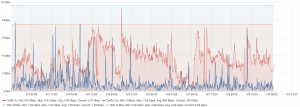With students returning to campus (or not) over the coming weeks, there appears to be a growing level of discussion about the impact on campus networks and Janet. The good news is we think everything is going to be ok.
The less good news is that we might have to do some upgrades to make sure that we keep ahead of the situation. I thought it might be good to give an overview of what we are doing to make sure that everything continues normally.
Peering
Most of the traffic that leaves/enters Janet does so across our dedicated peering links to the big content networks or via the various peering exchanges we are connected to. We already saw the need to increase capacity to the major UK access networks as users accessed their campuses via various remote routes such as VPN and VDI and we now have that additional capacity in place.
We will obviously continue to monitor these links and make sure that we add capacity where needed, or temporarily move traffic between private and public connections whilst we upgrade a link.
Transit
Whilst we have over 500G of transit capacity we don’t actually use that much and this traffic is usually to networks without much presence in Europe. Its primary function, however, is to provide an alternative for failures in our peers’ networks or act as an overflow in the case of large traffic events. This gives us the ability to add additional capacity to any network that suddenly starts increasing their traffic flows into Janet while we try and move their traffic to some form of peering (saving both us and that network in terms of costs).
Core
The Janet backbone currently has the capacity to deliver traffic a major increase in demand (such as a live sporting or news event) with little intervention from a human, with a little more intervention we can deliver much more (but please don’t take that as a challenge). There is already a plan to increase the capacity on the backbone to deal with the ever-increasing demands on the network as part of our annual backbone development.
Access Links
One of the bottlenecks in the chain is the connectivity to a campus. Whilst we continually monitor those links and start the process to upgrade links that are beginning to spike into the 70% band like this

connection, has just done in the last week, there is very little we can do instantly to increase capacity. Those organisations that have a second link can, of course, use that additional capacity with minor changes to the routing.
If you’ve been lucky enough to be part of the South JAP (or are about to be part of the South West transition) then additional capacity may have been added to the new connections as part of our standard long term planning process.
Campus
We’ve spoken to a number of organisations that have been rapidly deploying additional wireless access points and increasing the capacity into their halls of residence because they are unsure of the teaching patterns going forward and this seems like a sensible precaution.
We do highly recommend that you look at putting in some monitoring of the network and keep a weather eye on the situation during the early phases of return, but as is the nature of a multi-use network different parts of campus may have issues at different times. I expect to see a greater number of students watching entertainment content online in the evening rather than going out socialising with the current restrictions in place.
Jisc has also spoken to a number of providers of internet access to student accommodation about their connectivity (increasing peering capacity where identified) and their preparedness for additional traffic from content providers.
DDoS
Our security division has recently doubled the capacity of the DDoS protection platform and we’ve been looking at the options for more remote traffic cleaning if and when attacks become more sustained.
Summary
The takeaway from all this is if you think there’s going to be a massive increase in traffic on your network then speak to your account manager and we can look at the options for mitigating that additional level of traffic.
By James Blessing, post date 10th September 2020
